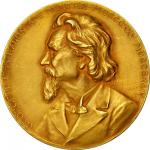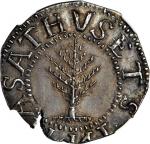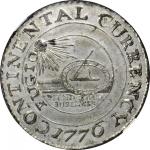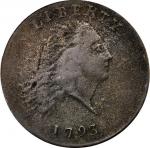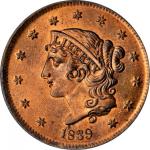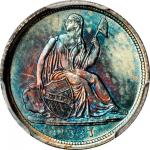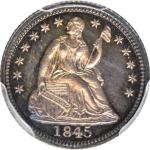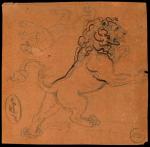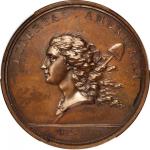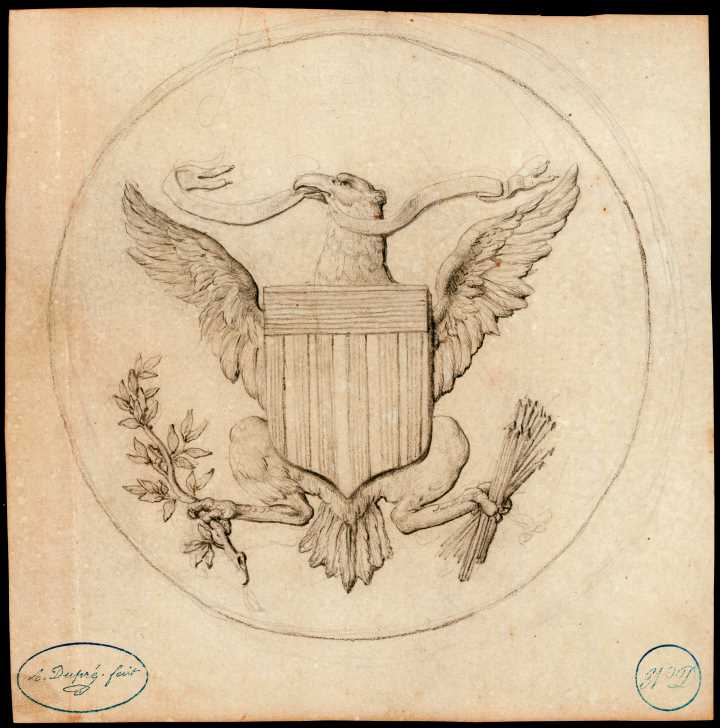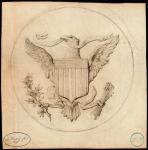The first graphite, 6 1/2 inches in diameter, on a slip of wove paper (7 3/4 inches x 7 5/8 inches; 197 mm x 195 mm), depicting the American eagle, facing left, bearing a shield and clutching an olive branch and arrows in his talons. The second graphite and sepia ink, 2 3/8 inches in diameter, on a clip of laid paper (4 3/8 inches x 5 1/4 inches; 111 mm x 134 mm), depicting a similarly designed eagle surmounted by 13 small circles with a larger circle (representing the unified 13 colonies) and lettered around the margin THE CONSULAR SEAL OF THE UNITED STATES OF AMERICA; both bearing an oval "studio" stamp with the wording "A.
Dupre. fecit" as well as a circular stamp with the initials N.D. (Narcisse Dupre).Thomas Jefferson first wrote to William Short, his representative in Paris, about the newly conceived Diplomatic medal on April 30, 1790, promising that he would soon send "a written description, and several impressions in wax," presumably of the already engraved consular seal after which the medal would be patterned. Jeffersons letter arrived in Shorts hands on June 11, and Short responded on June 14: "I shall employ Dupre to execute the medal you mention, after having consulted with the Abbe Barthelemi respecting those parts which are left undecided; and no time shall be lost in forwarding the business." Jeffersons and Shorts correspondence was fitful and uneven through most of 1790, and Jefferson complained bitterly of his letters that went unacknowledged.
The next mention of the Diplomatic medal and Dupres involvement in its production does not appear in their transatlantic conversation until Jeffersons letter of July 26, at which time Jefferson tells Short that "I presume the die will be finished by the time you receive this." To the contrary, no progress had been made at all. Short next wrote of the project in his letter to Jefferson dated September 26, 1790, at which time he reported: "Dupre is now engaged in engraving the medal you had ordered. As soon as it is finished your orders respecting it shall be executed." Assuming Shorts statement was accurate, the presently offered sketches presumably date from before September 26, 1790, when the Diplomatic medal was in its earliest design stage, before the first dies were engraved.These drawings were the only artwork related to the Diplomatic medal in the Dupre archive when it was sold in 2014.
While the Boston Public Library may hold related items (their collections also include a set of dies for the Diplomatic medal, along with a few uniface trials in tin), no other sketches are known in the United States. None are among the Dupre papers at the American Philosophical Society. None are illustrated or mentioned in Rosine Trogan and Philippe Sorels catalog of Dupres works held by the Musee Carnavalet.Beyond the importance of these sketches to numismatists, these artworks appear to be the earliest privately owned renditions of the Great Seal of the United States, earlier than even the Washington Oval Indian Peace medals of 1792 and 1793. As the Diplomatic Medal was commissioned by Jefferson as Secretary of State, these prefatory sketches enjoy a somewhat official status that ranks them as artistic treasures of national historical importance.


